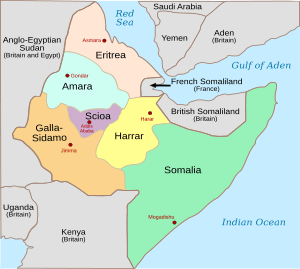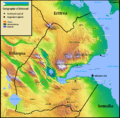Italian conquest of British Somaliland facts for kids
The Italian conquest of British Somaliland was a military campaign during World War II. Italy fought against the British Empire in this conflict. It was the only time Italy won a major battle against the Allies without help from Germany.
Contents
Why Italy Attacked British Somaliland
When Italy joined World War II in May 1940, its army in East Africa was not ready for a long war. Because of this, Italy's leader, Benito Mussolini, first ordered only small attacks. These attacks were meant to capture land along the borders of Kenya, Egypt, and Sudan.
In June 1940, Amedeo, Duke of Aosta, who was in charge of Italian East Africa, suggested a bigger plan. He wanted to conquer British Somaliland, a British colony. The King of Italy, Victor Emmanuel III, and Mussolini agreed. By early August, the plan was ready to begin.
Who Fought in the Battle
The Italian army attacking British Somaliland in August 1940 was led by General Guglielmo Nasi. His forces included five groups of colonial soldiers, three battalions of Blackshirts (a special Italian group), and three groups of local troops. The Italians also had 13 light tanks and 12 medium tanks, plus artillery. Most importantly, they had much stronger air support. In total, the Italian forces had about 4,800 Italian soldiers and about 30,000 local troops.
The British forces had about 4,000 soldiers. These included the Somaliland Camel Corps, led by Colonel Arthur Reginald Chater. Other British and Commonwealth troops were from the King's African Rifles, the Northern Rhodesian Regiment, the Punjab Regiment, and the Black Watch.
The Start of the Italian Attack
In the early morning of 3 August 1940, the Italian army crossed the border. They moved from Italian East Africa into British Somaliland.
The Italians attacked in three main directions. One group went north towards the port of Zeila. Another went to the center towards Adadlek. The third group moved south towards Odweina.
On 5 August, the port of Zeila was captured after tough fighting. This cut off any chance of help for the British from French Somaliland. The northern Italian group then moved south along the coast and took the village of Bulhar.
The Italian central group, led by Lieutenant-General Carlo De Simone, faced more challenges. The land was very mountainous. The British stopped them at the Karrin Pass, before the town of Hargeisa. Colonel Arthur Reginald Chater used his camel corps to fight and slow down the Italians. This allowed other British and Commonwealth forces to pull back towards Tug Argan.
The Battle at Tug Argan
By 6 August, just three days after the invasion, the towns of Zeila and Hargeisa were taken by the Italians. Odweina fell the next day. The Italian central and eastern groups then joined together. They began attacking the main British and Commonwealth positions at Tug Argan.
On 7 August, the British forces in British Somaliland received more soldiers. The 1st Battalion 2nd Punjab Regiment arrived. On 11 August, a new commander, Major-General Alfred Godwin-Austen, reached Tug Argan.
The British army's defenses were set up around six hills. These hills overlooked the only road leading to Berbera. On 11 August, an Italian group led by De Simone attacked one of these hills. It was defended by the 3rd Battalion 15th Punjab Regiment. The Italians captured it, but both sides had many casualties. The British tried to take it back twice but failed. The next day, they had to leave two other nearby hills.
By 14 August, the Italians started to surround the British defenders from their eastern positions. The British situation became very difficult.
After three days of fighting, on 15 August, Godwin-Austen decided that fighting more at Tug Argan would not help. He was worried about being completely surrounded. He contacted the British Middle East Command in Cairo, Egypt. He asked for and received permission to pull his forces out of British Somaliland.
The Black Watch battalion bravely covered the retreat. This allowed all the British and Commonwealth soldiers to get back to Berbera with very few losses.
British Escape from Berbera
While the British were retreating to Berbera, the British Royal Navy built a special dock. They started evacuating civilians and government officials. The two main Italian groups (the central and southern ones) met at the village of La Farruk. This was about 30 kilometers south of Berbera.
From Bulhar, the third Italian group reached the Berbera area on 14 August. However, the British defenders managed to hold them off. On 16 August, the British began loading troops onto waiting ships. They finished the evacuation by the afternoon of the next day. They sailed to Aden, in the Arabian peninsula. The Italians did not stop them much, thanks to a fierce bayonet charge by the Black Watch at Barkasan. The Somaliland Camel Corps was not evacuated; instead, it was disbanded.
On 19 August, the Italians took control of Berbera. They then moved along the coast to finish their conquest of British Somaliland. Mussolini added the British colony to the Italian Empire in Italian East Africa.
Who Won and What Happened Next
Italian historians say that during the campaign, the British army had 250 casualties, and the Italian army had 205. However, British records say their total casualties were 260. They estimated Italian losses were much higher, perhaps ten to twenty times more.
This campaign in Somaliland was like many others for the Axis powers. It started with a victory, but later ended in a complete defeat. This happened in places like the Balkans, the Philippines, and Russia. For the Italian conquest of British Somaliland, the defeat came in spring 1941. After that, Italian soldiers continued to fight a guerrilla war in Ethiopia for almost two more years.
British Somaliland remained part of Italian East Africa until March 1941. At that time, the 1st/2nd Punjab Regiment and the 3rd/15th Punjab Regiment returned from Aden to take back the territory.
Other pages
Images for kids
-
Kenyan troops from the 7th Battalion, King's African Rifles parading in Mogadishu, 1941
See also
 In Spanish: Conquista italiana de la Somalilandia británica para niños
In Spanish: Conquista italiana de la Somalilandia británica para niños













